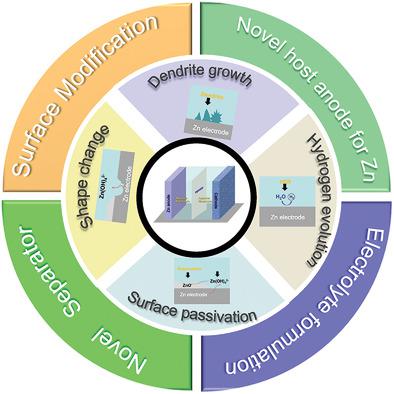当前位置:
X-MOL 学术
›
Adv. Sust. Syst.
›
论文详情
Our official English website, www.x-mol.net, welcomes your
feedback! (Note: you will need to create a separate account there.)
Challenges and Strategies for Constructing Highly Reversible Zinc Anodes in Aqueous Zinc‐Ion Batteries: Recent Progress and Future Perspectives
Advanced Sustainable Systems ( IF 6.5 ) Pub Date : 2020-06-09 , DOI: 10.1002/adsu.202000082 Yanxia Yu 1 , Wei Xu 2 , Xiaoqing Liu 1 , Xihong Lu 1, 2
Advanced Sustainable Systems ( IF 6.5 ) Pub Date : 2020-06-09 , DOI: 10.1002/adsu.202000082 Yanxia Yu 1 , Wei Xu 2 , Xiaoqing Liu 1 , Xihong Lu 1, 2
Affiliation

|
Aqueous zinc‐ion batteries (AZIBs) have attracted increasing attention as a next‐generation energy storage system because of their inherent safety, high capacity, and cost effectiveness. However, the poor cycling durability and low coulombic efficiency of zinc anodes substantially restrict their further development, which should be attributed to the severe dendrite growth, shape change, surface passivation, self‐corrosion, and byproduct formation across the repeated plating/stripping processes. To address these critical issues, great efforts have been dedicated to the rational design of zinc anodes. In this review, different strategies for the performance improvement of zinc anodes are summarized as well as recent research that boosts their development. These methods include the surface modification, novel host‐anode development for zinc, electrolyte formulation, and separator design. Their respective advantages and defects are compared and discussed in detail. The challenges and further prospects in this field are also addressed. This work is designed to shed light on advanced zinc anode constructions for high‐performance AZIBs assembly.
中文翻译:

在水性锌离子电池中构建高度可逆的锌阳极的挑战和策略:最新进展和未来展望
水性锌离子电池(AZIBs)由于其固有的安全性,高容量和成本效益,已作为下一代储能系统受到越来越多的关注。但是,锌阳极的较差的循环耐久性和低库伦效率大大限制了它们的进一步发展,这应归因于在反复电镀/剥离过程中严重的枝晶生长,形状变化,表面钝化,自腐蚀和副产物形成。为了解决这些关键问题,已经致力于锌阳极的合理设计。在这篇综述中,总结了改善锌阳极性能的不同策略以及促进其发展的最新研究。这些方法包括表面修饰,锌的新型主体阳极开发,电解质配方和隔板设计。比较并讨论了它们各自的优点和缺点。还解决了该领域的挑战和进一步的前景。这项工作旨在阐明用于高性能AZIB组装的高级锌阳极结构。
更新日期:2020-06-09
中文翻译:

在水性锌离子电池中构建高度可逆的锌阳极的挑战和策略:最新进展和未来展望
水性锌离子电池(AZIBs)由于其固有的安全性,高容量和成本效益,已作为下一代储能系统受到越来越多的关注。但是,锌阳极的较差的循环耐久性和低库伦效率大大限制了它们的进一步发展,这应归因于在反复电镀/剥离过程中严重的枝晶生长,形状变化,表面钝化,自腐蚀和副产物形成。为了解决这些关键问题,已经致力于锌阳极的合理设计。在这篇综述中,总结了改善锌阳极性能的不同策略以及促进其发展的最新研究。这些方法包括表面修饰,锌的新型主体阳极开发,电解质配方和隔板设计。比较并讨论了它们各自的优点和缺点。还解决了该领域的挑战和进一步的前景。这项工作旨在阐明用于高性能AZIB组装的高级锌阳极结构。











































 京公网安备 11010802027423号
京公网安备 11010802027423号